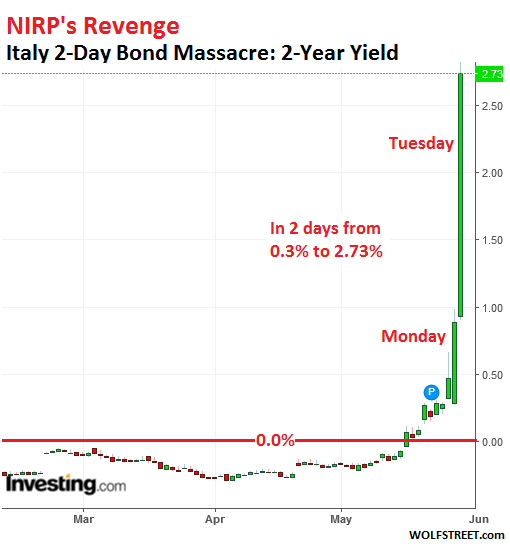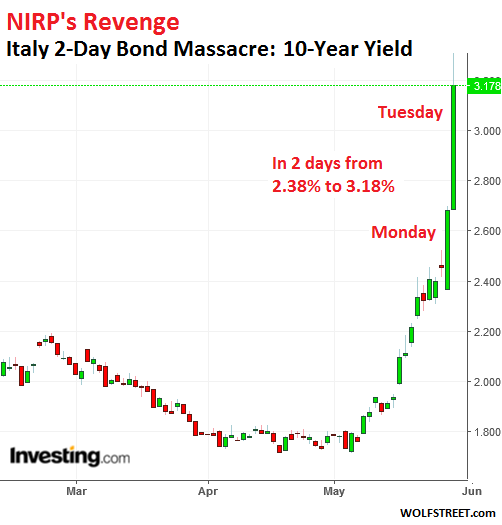Wolf Richter wolfstreet.com, http://www.amazon.com/author/wolfrichter
Markets wail and gnash their teeth as “normalization” of Italian yields sets in.
On Tuesday, Italian bonds had their worst day in Eurozone existence, even worse than any day during the worst periods of the 2011 debt crisis. And this comes after they’d already gotten crushed on Monday, and after they’d gotten crushed last week. And this happened even as the ECB is carrying on its QE program, including the purchase of Italian government bonds; and even as it pursues its negative-interest-rate policy (NIRP). As bond prices plunge, yields spike by definition, and the spike in the two-year yield was spectacular, going from 0.3% on Monday morning to 2.73% on Tuesday end of day:

But note that until May 26, the two-year yield was still negative as part of the ECB’s interest rate repression. On that fateful day, the two-year yield finallycrossed the red line into positive territory.
To this day, it remains inexplicable why the ECB decided that Italian yields with maturities of two years or less should be negative – that investors, or rather pension beneficiaries, etc., who own these misbegotten bonds, would need to pay the Italian government, one of the most indebted in the world, for the privilege of lending it money. But that scheme came totally unhinged just now.
The 10-year Italian government bond yield preformed a similar if not quite as spectacular a feat. Over Monday and Tuesday, it went from 2.37% to 3.18%:

But here’s the thing: Italian bonds – no matter what maturity – should never ever have traded with a negative yield. Their yields should always have been higher than US yields, given that the Italian government is in even worse financial shape than the US government. Italy’s debt-to-GDP ratio is 131%, and more importantly, it doesn’t even control its own currency and cannot on its own slough off a debt crisis by converting it into a classic currency crisis, which is how Argentina is dealing with its government spending. The central bank of Argentina recently jacked up its 30-day policy rate to 40% to keep the peso from collapsing further.
That’s the neighborhood where Italy would be if it had its own currency. But the ECB’s QE shenanigans and NIRP drove even Italian yields below zero, and so now here is NIRP’s revenge.
But just a little. In fact, Italian yields are in the process of “normalizing,” but they’re doing it swiftly, rather than “gradually,” as the Fed likes to emphasize at every opportunity for a very good reason: It took the Fed over four years to push up the two-year Treasury yield by 210 basis points. Italy accomplished the same feat in less than two days.
OK, normalization can be painful after years of NIRP. But just today – on the worst day for Italian bonds in Eurozone history – the government was able to sell €5.5 billion ($6.4 billion) six-month bills maturing in November 2018, at an average yield of 1.21%.
Let that 1.21% stew for a moment. In the US, today, the 6-month yield closed at 2.06%! So the Italian government is still borrowing at a lesser cost than the US government. Italy’s yield normalization has a long ways to go!
This was up from a negative yield of -0.42% at the prior six-month auction at the end of April. Oh my, how it hurts to have to pay interest on borrowed money, rather than getting paid for borrowing. I can hear the wailing and gnashing of teeth in Rome and in the markets around the world.
This six-month yield had reached an all-time high of 8.65% in November of 2011 and an all-time idiotic low of -0.48% in November last year. It needs to be way higher than it is today to account for at least some of the risks.
This yield normalization – or bloodbath, as others call it – comes on the heels of the failure of two anti-establishment parties, one on the left, the other on the right, to form a coalition government. They’d proposed to just blow off €250 billion of Italian bonds that the ECB has stupidly acquired, introduce an alternate currency, cut taxes, and raise spending.
If this plan had come to fruition, government bond yields would have spiked into the double digits, and a real default with big haircuts for investors would have been all but certain at those yields. Now the plan is off, the coalition hopes are in shambles, new elections are likely, and Italian voters get to sort this out, once again in their manner, in the voting booth.